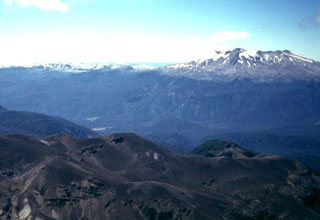Report on Puyehue-Cordon Caulle (Chile) — 11 December-17 December 2013
Smithsonian Institution / US Geological Survey
Weekly Volcanic Activity Report, 11 December-17 December 2013
Managing Editor: Sally Sennert.
Please cite this report as:
Global Volcanism Program, 2013. Report on Puyehue-Cordon Caulle (Chile) (Sennert, S, ed.). Weekly Volcanic Activity Report, 11 December-17 December 2013. Smithsonian Institution and US Geological Survey.
Puyehue-Cordon Caulle
Chile
40.59°S, 72.117°W; summit elev. 2236 m
All times are local (unless otherwise noted)
A scientist from NOAA's National Environmental Satellite, Data, and Information Service (NESDIS) reported that an ash cloud drifting NNE from the Cordón Caulle rift zone, part of the Puyehue-Cordón Caulle volcanic complex, was visible in satellite images starting at 0800 on 14 December. The scientist noted that, although it appeared to be a fresh emission, the cloud was likely re-suspended ash from strong southerly winds. In addition, no other evidence of renewed activity was detected.
Geological Summary. The Puyehue-Cordón Caulle volcanic complex (PCCVC) is a large NW-SE-trending late-Pleistocene to Holocene basaltic-to-rhyolitic transverse volcanic chain SE of Lago Ranco. The 1799-m-high Pleistocene Cordillera Nevada caldera lies at the NW end, separated from Puyehue stratovolcano at the SE end by the Cordón Caulle fissure complex. The Pleistocene Mencheca volcano with Holocene flank cones lies NE of Puyehue. The basaltic-to-rhyolitic Puyehue volcano is the most geochemically diverse of the PCCVC. The flat-topped, 2236-m-high volcano was constructed above a 5-km-wide caldera and is capped by a 2.4-km-wide Holocene summit caldera. Lava flows and domes of mostly rhyolitic composition are found on the E flank. Historical eruptions originally attributed to Puyehue, including major eruptions in 1921-22 and 1960, are now known to be from the Cordón Caulle rift zone. The Cordón Caulle geothermal area, occupying a 6 x 13 km wide volcano-tectonic depression, is the largest active geothermal area of the southern Andes volcanic zone.
Source: Michael J. Pavolonis (NOAA/NESDIS), personal communication

